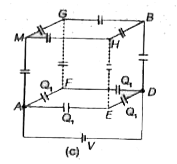Figure shows a combination of twelve capacitors, each pf capacitance C, forming a cube. Find the equivalent capacitance of the combination (i) between the diagonally opposite corners A and B of the cube (ii) between the diagonally opposite corners A and D of a face of the cube.

(a) Suppose the charge supplied by the battery is Q . This will be equally divided on the three capacitors connected to A because on looking from A to B three sides of the cube have indentical properties . Hence each capacitor connected to A has charge Q3 . Similarly each capacitor connected to B also has charge Q3 . In the figure ( b) the charges shown are the charges on the capacitors ( i.e charges on their positive plates )

Now V=(VA−VE)+(VE−VD)+(VD−VB)
=Q3C+Q/6C+Q/3C=506C
∴Ceq=QV=65C

(b) On looking from A to D into the circuit and from D to A into circuit we find symmetry . Henc the charge on each of the four capaitors of the face AEDF is same ( say Q1) . It means there is no charge on the capacitors between F and G nd between E and H . Hence to find the equivalent capacitance the combination may be taken without these two capacitors which has been shwon in the figure (d).

Topper's Solved these Questions
- ELECTROSTATIC POTENTIAL AND CAPACITANCE BOOK - AAKASH INSTITUTE ENGLISHCHAPTER - ELECTROSTATIC POTENTIAL AND CAPACITANCE EXERCISE - EXERCISE
20 Videos
- ELECTROSTATIC POTENTIAL AND CAPACITANCE BOOK - AAKASH INSTITUTE ENGLISHCHAPTER - ELECTROSTATIC POTENTIAL AND CAPACITANCE EXERCISE - ASSIGNMENT SECTION - A
44 Videos
- ELECTROSTATIC POTENTIAL AND CAPACITANCE BOOK - AAKASH INSTITUTE ENGLISHCHAPTER - ELECTROSTATIC POTENTIAL AND CAPACITANCE EXERCISE - SECTION-J Aakash Challengers Questions
5 Videos
- ELECTROMAGNETIC WAVESBOOK - AAKASH INSTITUTE ENGLISHCHAPTER - ELECTROMAGNETIC WAVESEXERCISE - ASSIGNMENT SECTION - D Assertion-Reason Type Questions
25 Videos
- GRAVITATION BOOK - AAKASH INSTITUTE ENGLISHCHAPTER - GRAVITATION EXERCISE - ASSIGNMENT SECTION - D (ASSERTION-REASON TYPE QUESTIONS)
15 Videos
Similar Questions
Find the equivalent capacitance of the combination between A and B in the figure.

View SolutionTwelve capacitors, each having a capacitance C, are connected to form a cube . Find the equivalent capacitance between the diagonally opposite corners such as A and B.

View SolutionFind the equivalent capacitances of the combinations shown in figure between the indicated points.

View SolutionFind the equivalent capacitance of the combination shown in figure (31.10) between the points P and N.

View SolutionFind the equivalent capacitance of each of the two combinations between A and B shown in the figures (a) and (b)

View SolutionA network of six identical capacitors, each of capacitance C is formed as shown below. The equivalent capacitance between the point A and B is

View SolutionIf each capacitor has capacitance C, then equivalent capacitance between A and B is

View SolutionTwelve wire, each having equal resistance r, are joined to form a cube as shown in figure.Find the equivalent resistance between the diagonally opposite points a and f.

View SolutionSix equal capacitors each of capacitance C are connected as shown in the figure. The equivalent capacitance between points A and B is

View SolutionThree equal capacitors, each with capacitance C are connected as shown in figure. Then the equivalent capacitance between A and B is

View Solution
